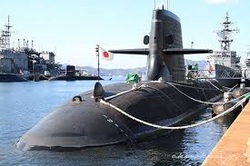 Source: akinokuni.jp
Source: akinokuni.jp If Mitsubishi Heavy Industries is in the running for the next submarine project, and if the submarines are constructed in Japan, this does not necessarily mean the end of the Australian naval shipbuilding industry. Far from it. It is more likely that the naval shipbuilding industry will resemble virtually every other major part of Australia’s defence industry – i.e., that it will be dominated by foreign companies with the expertise and funds to complete the projects needed by the Australian government. In the process of creating submarines using foreign expertise, Australia will have an opportunity to “go back to the drawing board”, as it were, to examine where its strengths are and where improvements can be made.
One area that has been sorely lacking is a trainee program for marine transport engineers. While AUSCAT maintains its own in-house training program, which has proven a great success in diversifying its workforce and project lines, the ASC, because it was focused purely on building ships for the navy, relied on pre-skilled engineers to fill in the gaps once projects were completed. That itself illustrates what one of the main problems of Australian naval shipbuilding has been – too much ‘exclusivity’, or an overreliance on building warships when other ships could have supplemented during the down time between major naval projects. As any observer of the Japanese method will tell you, Mitsubishi Heavy Industries and Kawasaki Heavy Industries kept their defence business operations going for more than 30 years by diversifying their build schedules between civilian and defence, which made them far more efficient at shipbuilding while raising engineers with a talent for designing advanced vessels.
If the Abbott government does want to make a difference to Australia’s naval shipbuilding industry, it would certainly be worthwhile having engineers (and other workers) undergo training in private industry such as that maintained by Mitsubishi Heavy Industries. This might mean establishing a school in Adelaide, or establishing a dormitory in Japan for trainees for the Australian program. If Japan is involved in the future submarine project, it will certainly need facilities in Adelaide to run tests on its vessels for Australian conditions (as well as provide a venue for integrating US defence systems on the submarine, if this is the path that the government ultimately takes).
The involvement of Japanese ship builders in the future submarine project could thus be a spark that rejuvenates Australia’s own naval shipbuilding industry rather than destroying it. If efficiency and cost-effectiveness are the government’s main concerns, tutelage under Japanese instruction could go a long way to addressing the deficiencies that have plagued Australia’s naval shipbuilding program. Would it be opposed? Almost certainly, with critics stating that Japan has no record of cooperation with other countries in shipbuilding, and that given Japan is not part of any formal Australian alliance network, entrusting future generations of shipbuilders to Japan may be a risky undertaking.
Yet Australia’s entire defence network is in the hands of foreign countries (or more accurately, foreign companies). Virtually every aspect of defence uses technologies and equipment garnered from either the US, Canada, Europe, or Israel. With defence cooperation with Asia a more pressing matter than ever, having Japanese involvement in Australia’s naval shipbuilding could help address the shortfall in Australia’s own domestic industry while providing it with the training for the future. It would, in fact, be a reverse of the experience of Japan in the early Meiji period. Japanese experts could provide the knowledge, and Australia could then use that knowledge to build its own capabilities. This could be a symbiotic relationship, providing each side with the benefits of cooperation and increasing the potential for expansion into other areas.
At this nascent stage in the development of Australia-Japan defence cooperation, Japan’s active involvement in the planning and construction of the next generation of submarines could be the litmus test for other countries interested in working with the Japanese and well as the Australian Defence Force.
 RSS Feed
RSS Feed